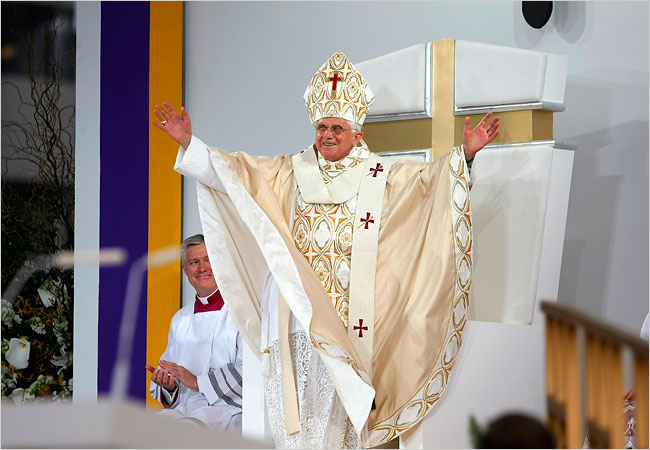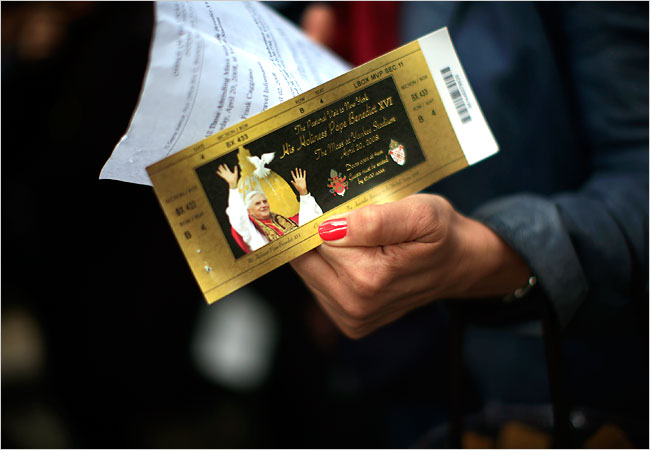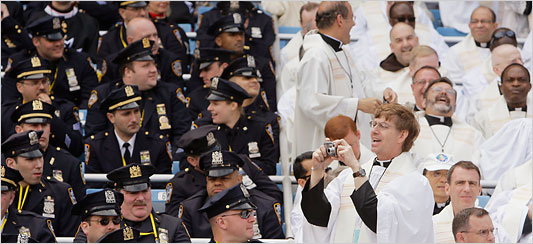By Sewell Chan
New York Times
April 20, 2008
http://cityroom.blogs.nytimes.com/2008/04/20/the-scene-at-yankee-stadium/?hp
 |
|
Pope Benedict XVI held a thurible, a metal censer, at the start of Mass at Yankee Stadium. Photo by Pool: Chang W. Lee/The New York Times |
Updated, 5:18 p.m. | Citing the role that Roman Catholic churches, schools and social institutions have played in American history, Pope Benedict XVI used his homily in a Mass for nearly 60,000 at Yankee Stadium to call for unity among Catholics, to declare that "true freedom" often requires authority and obedience, and to speak out against abortion " an issue over which many American Catholics disagree with the church.
Over all, the popes message, like that of most of his public events during this visit to the United States, was one of joy and hope, not doctrinal orthodoxy. The Mass, which lasted about 2 hours and 15 minutes under sunny, seasonable skies, came on the final day of Benedicts six-day visit to the United States. The papal jet is scheduled to fly back to the Vatican at 8:30 p.m. tonight from Hangar 19 at Kennedy International Airport.
The papal Mass " the third in the 85-year history of the stadium, which will soon be demolished and replaced by a new Yankee Stadium being erected immediately to the north " was a commemoration of the 200th anniversary of the founding of the dioceses of New York, Boston, Philadelphia and Louisville in 1808. (The Baltimore diocese was established in 1789 as the first diocese in the United States, and became an archdiocese, the countrys first, in 1808, when the four new dioceses were created. Its bicentennial as an archdiocese is also being celebrated in todays Mass.) The pope praised the United States as a land where Catholics found freedom not only to practice their faith, but also "to participate fully in civic life."
The pope said in his homily that "authority" and "obedience" are "not easy words to speak nowadays," particularly "in a society which rightly places a high value on personal freedom." But, the pope added, "The Gospel teaches us that true freedom, the freedom of the children of God, is found only in the self-surrender which is part of the mystery of love. Only by losing ourselves, the Lord tells us, do we truly find ourselves."
The pope also used the bicentennial to trace the growth of church in the United States:
In these 200 years, the face of the Catholic community in your country has changed greatly. We think of the successive waves of immigrants whose traditions have so enriched the Church in America. We think of the strong faith which built up the network of churches, educational, health care and social institutions which have long been the hallmark of the Church in this land. We think also of those countless fathers and mothers who passed on the faith to their children, the steady ministry of the many priests who devoted their lives to the care of souls, and the incalculable contribution made by so many men and women religious, who not only taught generations of children how to read and write, but also inspired in them a lifelong desire to know God, to love him and to serve him.
Other than reiterating his support for immigrants " a theme that has resonated in the national debates over immigration policy " the pope avoided any direct of some social issues on which he and many if not most American Catholics disagree: contraception, homosexuality and the whether women should be admitted to the priesthood.
The pope, who has mentioned the sexual abuse scandal in the priesthood several times during his visit, referred only obliquely to it in his homily today, when he said that "praying fervently for the coming of the Kingdom" means, among other things, "not losing heart in the face of resistance, adversity and scandal."
The pope drew some applause when he made a statement against abortion, saying that the "unchanging truths" grounded in Jesus Christ "alone can guarantee respect for the inalienable dignity and rights of each man, woman and child in our world " including the most defenseless of all human beings, the unborn child in the mothers womb."
Following the homily, a choir sang the profession of faith in Latin and prayers were made for the five archdioceses, victims of war and persecution, the vulnerable and sick, priests and those in religious life, and "the departed, especially our immigrant ancestors and those who built and sustained our communities of faith." Then the pope began the liturgy of the Eucharist, the central part of the Mass, shortly after 4 p.m.
The distribution of communion took more than 20 minutes " substantially longer than the 14 minutes that had been allotted for the distribution of more than 50,000 wafers. About 530 priests and deacons handled the distribution of communion; the pope personally distributed communion to about 50 people.
At 4:39 p.m., the pope conferred his apostolic blessing on the congregation. He also blessed two objects: a cornerstone for the bicentennial garden at St. Patricks Cathedral (where the pope celebrated Mass for priests, deacons and members of religious orders on Saturday) and a crucifix that will be placed in the chapel of Saint John Neumann Residence & Hall. The Mass ended at 4:40 p.m. The pope made his way back to the sacristy, where he changed out of the vestments he had worn for the Mass, and entered the Popemobile at 5 p.m., waving while the crowd cheered and applauded. The pope exited the stadium at 5:06 p.m., moving from the Popemobile to a waiting motorcade to take him back to Manhattan.
3:19 p.m. | Nearly 60,000 Catholics packed into Yankee Stadium erupted in a roar of applause when the Popemobile entered the stadium at 2:19 p.m. As the papal vehicle made its way around the baseball field, many of those in the crowd waved yellow and white handkerchiefs, the colors of the Holy See. The Mass will be the third papal Mass in the stadiums history " following Masses said there by Pope Paul VI in 1965 and Pope John Paul II in 1979. (John Paul returned to New York in 1995 and said Mass at several locations here, including the Great Lawn of Central Park.)
Wearing a white mozzetta, the pope stepped out of the Popemobile at 2:25 p.m. He disappeared behind the altar into a makeshift sacristy, to don the vestments he will wear to celebrate communion. Then he ascended the altar, said "The Lord be with you," and sat on the papal throne.
Cardinal Edward M. Egan, the archbishop of New York, called the popes visit "an immense blessing for which we are truly and deeply grateful." In the crowd, Cardinal Egan noted, were clergy or members of religious orders from all 195 archdioceses and dioceses in the United States.
After the penitential rite and the kyrie, a central element of the Catholic liturgy, Catherine Hickey, superintendent of schools for the Archdiocese of New York, gave the first reading, from the Acts of the Apostle (Acts 6: 1-7). Beatrice Diaz Taveras, another Archdiocesan official, gave the second reading, in Spanish, from the first book of Peter (1 Peter 2: 4-9). A deacon gave a reading from the Gospel according to John (John 14:1-2).
Among the high-ranking clerics in the audience were Cardinal Tarcisio Bertone, the Vatican secretary of state; Cardinal John P. Foley, grand master of the Equestrian Order of the Holy Sepulchre of Jerusalem; Cardinal Daniel N. DiNardo, archbishop of Galveston-Houston; Cardinal Anthony J. Bevilacqua, former archbishop of Philadelphia; Cardinal William H. Keeler, former archbishop of Baltimore; Cardinal Theodore E. McCarrick, former archbishop of Washington; Archbishop Fernando Filoni, substitute of the Vatican secretary of state; Archbishop Celestino Migliore, the apostolic nuncio to the United Nations and the popes host for the New York portion of his United States visit; Archbishop James M. Harvey, prefect of the papal household; Archbishop Edward OBrien of Baltimore; and Archbishop Joseph E. Kurtz of Louisville.
 |
|
The pope received a standing ovation at the stadium. Photo by Pool: Chang W. Lee/The New York Times |
Catholics who woke up early this morning to wait patiently in line to enter the stadium " hours before the pope himself arrived " said they were elated at having the opportunity to see the pontiff.
"Its like Jesus Christ visiting America," Clemens Semon, 50, an immigrant from Ivory Coast who lives with his wife Elizabeth, also 50, live in Ozone Park, Queens, said on his way into the Mass. He said he believed the pope was a force for unity and peace. "You see how many pack together, come together to see him? Hes a unifier, he brings hope and peace."
Those in the congregation were required to enter the stadium, pass through security and take their seats by noon, after which the stadium was effectively sealed for security reasons. To keep the crowd entertained, the Archdiocese of New York hired a California event producer, Stig Edgren, to organize a live musical performance. The performers included the Harlem Gospel Choir, the Irish tenor Ronan Tynan, the Italian tenor Marcello Giordani, the Puerto Rican singer and guitarist Jose Feliciano, the Brooklyn-born rhythm-and-blues and soul singer Stephanie Mills, and the jazz and pop singer Harry Connick Jr.
Inside the stadium were a number of local political figures, including Gov. David A. Paterson, Mayor Michael R. Bloomberg, Representative Vito J. Fossella, a Staten Island Republican, and Councilman Leroy G. Comrie Jr., a Queens Democrat.
Outside Yankee Stadium a cottage industry in pope related items had sprung up. There were buttons, flags and pennants, canvas tote bags and portraits. Blue plastic cushions with the words "Savior Seat" and an illustration of clasped hands and a halo were going for $10 a piece, or 2 for $15 " the same as T-shirts with a photograph showing the pope holding a crozier in one hand and raising the other hand in benediction.
There were more people than tickets outside the stadium and some of the faithful had taken a page from a playbook used in the past by rock fans. They were holding aloft handwritten signs beseeching passers-by for a free ticket. As the sound of a pipe organ issued from inside the stadium, Krystyna Sevilla, from Forest Hills, Queens, stood beneath the elevated train track that runs above River Ave. holding a sign that read, "I need ticket please." She said,"This is a spiritual thing. Im very honored to be here in a Catholic community participating in a wonderful ceremony."
Stans Sports Bar and Grill was open for business but the few patrons who were present were drinking coffee instead of beer and the images from Yankee Stadium broadcast on the television screens showed people gathered to see the pope instead of the Yankees.
The roughly 57,000 tickets were distributed months ago, through an intricate system. About half of the tickets went to the Archdiocese of New York; the rest went to dioceses across the United States, but with a sizable proportion reserved for the dioceses Boston, Baltimore, Philadelphia and Louisville.
 |
|
A woman held a ticket for Mass at Yankee Stadium. Photo by Eric Thayer/Getty Images |
Although the tickets were long gone, crowds of spectators nevertheless stood outside the stadium, hoping for at least a glimpse of the pope or a miracle that would allow them into the heavily fortified stadium.
Marie Smith, 26, a dental assistant from Flatbush, Brooklyn, who waited with her son Julien, 6, said she did not know she needed tickets for the papal Mass. "Hes the icon of all the Catholics," she said of the pope. "I want to be able to talk to him, ask him to pray for me."
Rita Witty, 68, a home attendant who lives in the Bronx and describes herself as a staunch Catholic, said, "If I see him, to me, its just like seeing God on the face of the earth."
The Rev. Robert Hoatson, 56, a Catholic priest who is known for his outspoken advocacy for victims of sexual abuse by priests, was one of a small number of protesters outside the stadium.
Father Hoatson said he was sexually abused as a Christian brother between the ages of 18 and 30. He said he was put on administrative leave in 2005 after emerging as because he started an organization to help victims of clergy abuse called Road to Recovery. He held up a sign that read: "Sexual abuse of little boys and girl is soul murder."
Father Hoatson said, however, that he was gratified that the pope made a surprise visit last week with victims of sexual abuse by priests. "We want to remind the pope that his words to survivors in D.C. need to put into action," Father Hoatson said, "Hes got to walk the walk."
The priest continued, "The fact that he has spoken so much about it is indicative that he wants to take the bull by the horns." He said his goal was "to convince Catholics to listen to the pope who has said this was handled poorly, that the abused need justice."
Colin Moynihan and Bernard Vaughn contributed reporting.
 |
|
One of the 530 priests entrusted with distributing communion took a photograph. Photo by Julie Jacobson/Associated Press |
Any original material on these pages is copyright © BishopAccountability.org 2004. Reproduce freely with attribution.